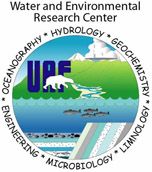

 |
 |
||
 |

Intersections of water, |
||
Seward Peninsula water resources and use: past, present, and future
The Seward Peninsula extends from the northwest coast of Alaska, surrounded by Norton Sound, Kotzebue Sound, and the Bering Strait. The peninsula is approximately 46,000 square km and home to approximatley 5,600 people. Nome, the hub of the Seward Peninsula, sits on the southern coast. Gold discovered near the turn of the 20th century brought a population boom. Temperature and precipitation data collected in Nome since the early 20th century provides a relatively long record for sub-arctic climate. Situated along the southern boundary of continuous permafrost, the Seward Peninsula is a good location to observe permafrost in a changing arctic environment.
This project consists of 4 main parts. Permafrost hydrologists Larry Hinzman and Bob Busey have built and run a model to apply measured temperatures over the 20th century and projected temperatures over the 21st century to estimate the average annual temperature at the top of the permafrost table. The output indicates where continuous permafrost is sustainable, where discontinuous permafrost is expected, and where ground should be thawing or permafrost free. The water use group, consisting of Dan White, Molly Chambers, and Erin Strang, summarized water use over the 20th century, projected water use for the 21st century, and measured conductivity and biological quality of present water sources to estimate their reliability and suitability. Anthropologists Peter Schweitzer, Beth Marino, and Josh Wisniewski conducted interviews in several communities and continue to seek to understand the local knowledge and use of water resources. Lilian Alessa and Andrew Kliskey are constructing a biophysical model to compile the geographic information gathered by the project and locate 'hotspots' of vulnerability to climate variability.
Project Components
Hydrology and Permafrost
Present water balance and permafrost conditions
Future permafrost model and impacts on water availability
Water Resource Use
Historical water use: Domestic and Industrial
Present water supply: Infrastructure and source quality
Future water source reliability and projected demand
Anthropology of freshwater use and freshwater-sensitive subsistence resources
Biophysical Modelling: Resilience, adaptation, and community vulnerability
Related Links and Downloads
This material is based upon work supported by the National Science Foundation under Grant No. OPP-0328686. Any opinions, findings, and conclusions or recommendations expressed in this material are those of the authors and do not necessarily reflect the views of the National Science Foundation. UAF is an affirmative action/equal opportunity employer and educational institution. The University of Alaska Fairbanks is accredited by the Northwest Commission on Colleges and Universities.
|
_